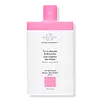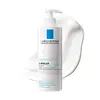What's inside
What's inside
 Key Ingredients
Key Ingredients

 Benefits
Benefits

 Concerns
Concerns

 Ingredients Side-by-side
Ingredients Side-by-side

Water
Skin ConditioningGlycolic Acid
BufferingCoconut Alkanes
EmollientSodium Hydroxide
BufferingHydroxyethyl Acrylate/Sodium Acryloyldimethyl Taurate Copolymer
Emulsion StabilisingPropanediol
SolventCetearyl Alcohol
EmollientSqualane
EmollientCetearyl Olivate
Sorbitan Olivate
EmulsifyingSclerocarya Birrea Seed Butter
EmollientButyrospermum Parkii Butter
Skin ConditioningCamellia Sinensis Seed Oil
HumectantPassiflora Edulis Seed Oil
EmollientNiacinamide
SmoothingSodium PCA
HumectantLactic Acid
BufferingTartaric Acid
BufferingSclerocarya Birrea Seed Oil
HumectantCocos Nucifera Fruit Juice
EmollientAdansonia Digitata Seed Oil
EmollientSchinziophyton Rautanenii Kernel Oil
EmollientCoco-Caprylate/Caprate
EmollientCitrullus Lanatus Seed Oil
EmollientCocos Nucifera Oil
MaskingTapioca Starch
Vitis Vinifera Juice Extract
AntioxidantPrunus Armeniaca Kernel Oil
MaskingSimmondsia Chinensis Seed Oil
EmollientXimenia Americana Seed Oil
EmollientSodium Hyaluronate Crosspolymer
HumectantAllantoin
Skin ConditioningQuercetin
AntioxidantLinoleic Acid
CleansingLinolenic Acid
CleansingPrunus Amygdalus Dulcis Oil
Skin ConditioningPersea Gratissima Oil
Skin ConditioningTocopherol
AntioxidantCitric Acid
BufferingSorbitan Isostearate
EmulsifyingPolysorbate 60
EmulsifyingChlorphenesin
AntimicrobialPhenoxyethanol
PreservativeCaprylyl Glycol
EmollientPotassium Sorbate
PreservativePentylene Glycol
Skin ConditioningSodium Carbonate
BufferingSodium Chloride
MaskingEthylhexylglycerin
Skin ConditioningWater, Glycolic Acid, Coconut Alkanes, Sodium Hydroxide, Hydroxyethyl Acrylate/Sodium Acryloyldimethyl Taurate Copolymer, Propanediol, Cetearyl Alcohol, Squalane, Cetearyl Olivate, Sorbitan Olivate, Sclerocarya Birrea Seed Butter, Butyrospermum Parkii Butter, Camellia Sinensis Seed Oil, Passiflora Edulis Seed Oil, Niacinamide, Sodium PCA, Lactic Acid, Tartaric Acid, Sclerocarya Birrea Seed Oil, Cocos Nucifera Fruit Juice, Adansonia Digitata Seed Oil, Schinziophyton Rautanenii Kernel Oil, Coco-Caprylate/Caprate, Citrullus Lanatus Seed Oil, Cocos Nucifera Oil, Tapioca Starch, Vitis Vinifera Juice Extract, Prunus Armeniaca Kernel Oil, Simmondsia Chinensis Seed Oil, Ximenia Americana Seed Oil, Sodium Hyaluronate Crosspolymer, Allantoin, Quercetin, Linoleic Acid, Linolenic Acid, Prunus Amygdalus Dulcis Oil, Persea Gratissima Oil, Tocopherol, Citric Acid, Sorbitan Isostearate, Polysorbate 60, Chlorphenesin, Phenoxyethanol, Caprylyl Glycol, Potassium Sorbate, Pentylene Glycol, Sodium Carbonate, Sodium Chloride, Ethylhexylglycerin
Water
Skin ConditioningButyrospermum Parkii Butter
Skin ConditioningGlycerin
HumectantDimethicone
EmollientUrea
BufferingParaffinum Liquidum
EmollientSodium Lactate
BufferingCetearyl Alcohol
EmollientPEG-100 Stearate
Glyceryl Stearate
EmollientPropylene Glycol
HumectantGlycine
BufferingStearic Acid
CleansingDimethiconol
EmollientSodium Hydroxide
BufferingPalmitic Acid
EmollientDisodium EDTA
Hydroxyethylpiperazine Ethane Sulfonic Acid
BufferingXanthan Gum
EmulsifyingAcrylates/C10-30 Alkyl Acrylate Crosspolymer
Emulsion StabilisingTocopherol
AntioxidantPhenoxyethanol
PreservativeChlorhexidine Digluconate
AntimicrobialParfum
MaskingWater, Butyrospermum Parkii Butter, Glycerin, Dimethicone, Urea, Paraffinum Liquidum, Sodium Lactate, Cetearyl Alcohol, PEG-100 Stearate, Glyceryl Stearate, Propylene Glycol, Glycine, Stearic Acid, Dimethiconol, Sodium Hydroxide, Palmitic Acid, Disodium EDTA, Hydroxyethylpiperazine Ethane Sulfonic Acid, Xanthan Gum, Acrylates/C10-30 Alkyl Acrylate Crosspolymer, Tocopherol, Phenoxyethanol, Chlorhexidine Digluconate, Parfum
 Reviews
Reviews

Ingredients Explained
These ingredients are found in both products.
Ingredients higher up in an ingredient list are typically present in a larger amount.
This ingredient is also known as shea butter. It is an effective skin hydrator and emollient.
Emollients help soothe and soften your skin. It does this by creating a protective film on your skin. This barrier helps trap moisture and keeps your skin hydrated. Emollients may be effective at treating dry or itchy skin.
Shea butter is rich in antioxidants. Antioxidants help fight free-radicals, or molecules that may harm the body. It is also full of fatty acids including stearic acid and linoleic acid. These acids help replenish the skin and keep skin moisturized.
While Shea Butter has an SPF rating of about 3-4, it is not a sunscreen replacement.
Shea butter may not be fungal acne safe. We recommend speaking with a professional if you have any concerns.
Learn more about Butyrospermum Parkii ButterCetearyl alcohol is a mixture of two fatty alcohols: cetyl alcohol and stearyl alcohol. It is mainly used as an emulsifier. Emulsifiers help prevent the separation of oils and products. Due to its composition, it can also be used to thicken a product or help create foam.
Cetearyl alcohol is an emollient. Emollients help soothe and hydrate the skin by trapping moisture.
Studies show Cetearyl alcohol is non-toxic and non-irritating. The FDA allows products labeled "alcohol-free" to have fatty alcohols.
This ingredient is usually derived from plant oils such as palm, vegetable, or coconut oils. There is debate on whether this ingredient will cause acne.
Due to the fatty acid base, this ingredient may not be Malassezia folliculitis safe.
Learn more about Cetearyl AlcoholPhenoxyethanol is a preservative that has germicide, antimicrobial, and aromatic properties. Studies show that phenoxyethanol can prevent microbial growth. By itself, it has a scent that is similar to that of a rose.
It's often used in formulations along with Caprylyl Glycol to preserve the shelf life of products.
Sodium Hydroxide is also known as lye or caustic soda. It is used to adjust the pH of products; many ingredients require a specific pH to be effective.
In small amounts, sodium hydroxide is considered safe to use. However, large amounts may cause chemical burns due to its high alkaline.
Your skin has a natural pH and acid mantle. This acid mantle helps prevent harmful bacteria from breaking through. The acid mantle also helps keep your skin hydrated.
"Alkaline" refers to a high pH level. A low pH level would be considered acidic.
Learn more about Sodium HydroxideTocopherol (also known as Vitamin E) is a common antioxidant used to help protect the skin from free-radicals and strengthen the skin barrier. It's also fat soluble - this means our skin is great at absorbing it.
Vitamin E also helps keep your natural skin lipids healthy. Your lipid skin barrier naturally consists of lipids, ceramides, and fatty acids. Vitamin E offers extra protection for your skin’s lipid barrier, keeping your skin healthy and nourished.
Another benefit is a bit of UV protection. Vitamin E helps reduce the damage caused by UVB rays. (It should not replace your sunscreen). Combining it with Vitamin C can decrease sunburned cells and hyperpigmentation after UV exposure.
You might have noticed Vitamin E + C often paired together. This is because it is great at stabilizing Vitamin C. Using the two together helps increase the effectiveness of both ingredients.
There are often claims that Vitamin E can reduce/prevent scarring, but these claims haven't been confirmed by scientific research.
Learn more about TocopherolWater. It's the most common cosmetic ingredient of all. You'll usually see it at the top of ingredient lists, meaning that it makes up the largest part of the product.
So why is it so popular? Water most often acts as a solvent - this means that it helps dissolve other ingredients into the formulation.
You'll also recognize water as that liquid we all need to stay alive. If you see this, drink a glass of water. Stay hydrated!
Learn more about Water